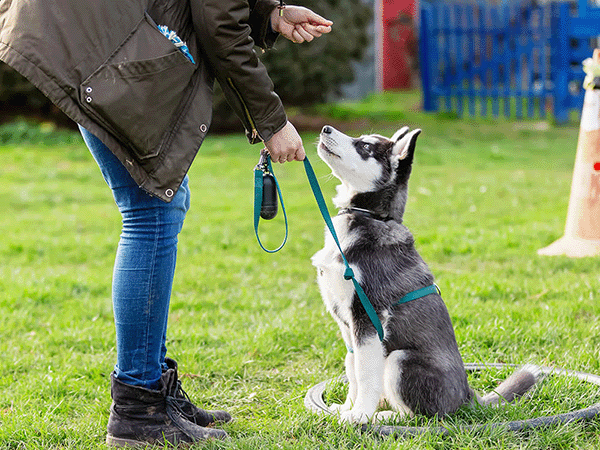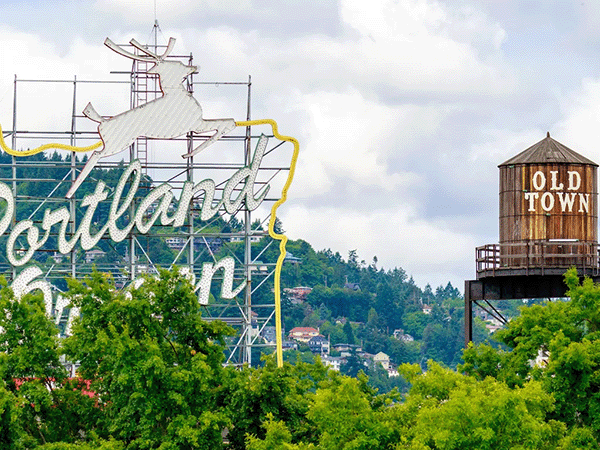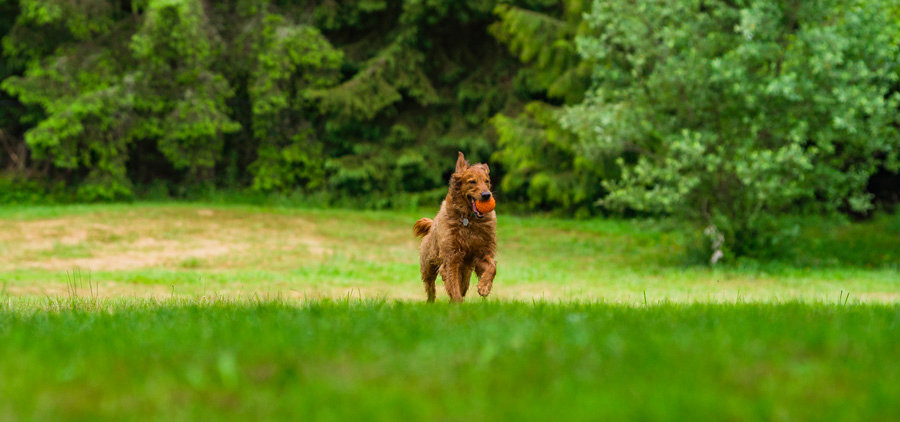Puppy Training: How to Stop Leash Aggression

Is your puppy's leash pulling turning walks into a wrestling match? Don't worry, you're not alone. Many new puppy owners struggle with puppy training for leash aggression. This guide will help you understand why your puppy acts out on the leash, tell the difference between excitement and true aggression, and give you simple, effective training techniques. Let's turn those frustrating walks into fun adventures for both of you!
Here are some key things to know. You can help your pup grow up into a happy, confident, well-behaved dog! We cover:
- Definitions of leash aggression and leash reactivity
- Types of leash reactivity (fear and frustration)
- How leash aggression develops in young dogs
- How to tell if your puppy has leash reactivity—or if their behavior is normal for a young dog
- If puppy leash aggression leads to adult behavioral problems
- Further dog reactivity resources
Is Leash Aggression the Same as Leash Reactivity?Are leash aggression and leash reactivity the same thing?
Everyone’s favorite answer: It depends.
Many dog trainers, pet parents, and veterinarians use “leash aggression” and “leash reactivity” interchangeably. They terms can have slightly different nuances in meaning, though, depending on who you ask.
Key Takeaways
- Address leash reactivity early: Whether rooted in fear or frustration, early intervention through positive reinforcement and controlled socialization sets puppies up for success. Sniffspot's private dog parks offer a safe space for off-leash practice and confidence building.
- Recognize true reactivity: Observe your puppy's body language. Stiffness, whale eye, or fixating on triggers may signal more than just excitement. Consistent reactions to specific stimuli also warrant attention.
- Seek professional support: Consult a certified trainer or veterinary behaviorist for guidance. They can help determine the cause of reactivity and create a tailored training plan. Management tools like front-clip harnesses can be helpful, but remember to introduce them positively and prioritize a calm, supportive approach.
What is Leash Aggression?
Leash aggression refers to a dog displaying aggressive behavior on a leash. It can manifest as growling, barking, lunging, or even attempting to bite.
Dominance Aggression
Dominance aggression isn’t as common as some people think. While dogs do have social hierarchies, dominance aggression isn’t usually the root cause of unwanted behaviors. It’s more likely to be fear, anxiety, or even just plain excitement. Instead of assuming dominance, consider other factors first.
Dominance aggression can happen, though. It’s most common when a dog reaches social maturity (around two years old). However, it can sometimes show up in puppies as young as five months old—or even in older dogs. Dominance aggression usually involves resource guarding (protecting food, toys, or even a favorite person). It can also involve challenging other dogs for social status. If you're concerned about your dog potentially exhibiting dominance aggression, especially at a dog park, it's always best to consult with a professional trainer.
Territorial Aggression
Territorial aggression is a natural dog behavior. Dogs, like humans, use aggression (and the threat of aggression) to maintain order and negotiate social interactions. Think of it as a way of setting boundaries. This can be especially apparent in environments like a Sniffspot, where dogs may feel a sense of ownership over the space.
Territorial aggression can look like a lot of different things. It can range from warning signs (like growling or barking) to more serious behaviors (like lunging or biting). It’s important to remember that “aggression” is a broad term. A dog showing territorial aggression might just be trying to communicate their discomfort or protect what they see as their space. If you notice these behaviors escalating, consider seeking guidance from a certified dog trainer or behaviorist.
What is Leash Reactivity?
Leash reactivity can be a broader term. Reactivity might encompass a range of behaviors your dog exhibits while on a leash—not only traditionally aggressive behaviors but also fearful, anxious, or overly excited emotional responses.
Per Sniffspot’s proprietary survey research, 66% of dogs are reported by their guardians to be reactive. Of these, 65% are leash reactive specifically.
Treating Leash Reactivity and Aggression
Both “leash aggression” and “leash reactivity” refer to undesirable behaviors (like barking, growling, lunging, whining and pulling) your puppy might show when they encounter a specific trigger (like other pets, strangers, bikes, or cars) on leash. In this article we’ll use both terms interchangeably.

Identifying Triggers and Approach/Avoidance Preferences
Figuring out what’s causing your dog’s leash reactivity is the first step. Does your dog lunge and bark at other dogs, or cower behind you? Knowing whether your dog wants to approach or avoid the trigger helps determine the best training approach. For example, a dog who wants to approach other dogs likely exhibits frustration-based reactivity, while a dog trying to hide is probably experiencing fear. Understanding the motivation behind the behavior is key.
Desensitization and Counterconditioning
Positive reinforcement training is incredibly effective for leash reactivity. This involves associating the presence of triggers—like other dogs—with positive experiences. When you see another dog approaching, start giving your puppy high-value treats and praise. The goal is to change their emotional response from negative (fear or frustration) to positive (yay, treats!). This method, called desensitization and counterconditioning, takes time and patience, but it’s a powerful way to help your dog learn.
Management Techniques: Creating Distance and Avoiding Triggers
Sometimes, the best approach is to avoid situations that trigger your dog’s reactivity. If you live in a busy area with lots of dogs, try finding quieter places for walks, especially during initial training. Creating distance between your dog and their triggers reduces stress and prevents reinforcing the reactive behavior. Managing a leash-reactive dog often involves strategically planning your walking routes and avoiding known triggers.
Utilizing Sniffspot's Dog Parks for Controlled Socialization
For controlled socialization, consider using Sniffspot's private dog parks. These offer a safe, enclosed environment where your puppy can interact with other dogs at their own pace. Off-leash play in a controlled environment can be incredibly beneficial for building confidence and positive social interactions, especially for puppies working through leash reactivity.
Emergency U-Turns and Other Avoidance Strategies
If your dog is already showing signs of leash aggression, professional help is essential. A certified dog trainer or veterinary behaviorist can diagnose the underlying cause and create a tailored training plan. Professional guidance is invaluable for addressing more serious cases of leash aggression. In the meantime, develop some avoidance strategies. An emergency U-turn can be a lifesaver when you encounter a trigger unexpectedly. Practice this maneuver so you can execute it smoothly and confidently.
Training Tools: Harnesses, Head Halters, and Muzzles
Specialized equipment like front-clip harnesses, head halters, or muzzles can be helpful management tools. A front-clip harness discourages pulling, while a head halter gives you more control over your dog’s head. Muzzles prevent biting and can provide a sense of security for both you and others. Remember, these tools are meant for management, not punishment, and should be introduced gradually and positively.
Introducing Tools Positively and Avoiding Corrections
It’s crucial to introduce any new training tool positively. Pair the tool with treats and praise so your dog develops a positive association. Never use punishment (yelling, jerking the leash) when your dog reacts. Punishing a reactive dog only increases their anxiety and can worsen the behavior. Focus on positive reinforcement and creating a safe, comfortable experience for your dog.
The Importance of Loose-Leash Walking
Teaching your puppy to walk politely on a loose leash is a foundational skill that can help prevent leash reactivity. Loose-leash walking means the leash is loose and relaxed, not tight. This teaches your dog to walk calmly beside you without pulling or lunging, reducing the likelihood of reactive outbursts.
Stop-and-Go Method
One effective technique for loose-leash walking is the stop-and-go method. If your dog starts to pull, immediately stop walking. Only resume walking when the leash becomes slack again. This teaches your dog that pulling gets them nowhere and reinforces the importance of a loose leash.
Reinforcement Zone Training
Reinforcement zone training involves teaching your dog to stay in a desired position beside you. Use treats and praise to reward them for staying in that “zone.” This method helps your dog understand where you want them to be while walking, promoting a more focused and controlled walk.
Addressing the Owner's Anxiety
It’s important to be mindful of your own anxiety. Dogs are very perceptive and can pick up on your emotions. If you’re tense and anxious, your dog may become anxious too. Try to stay calm and relaxed during walks, and keep the leash loose. Deep breaths can help both you and your dog stay calm and focused.
Ruling Out Medical Issues
Sometimes, what appears to be leash reactivity can actually be caused by an underlying medical condition. Pain or discomfort can make dogs irritable and more likely to react. It’s always a good idea to consult with your veterinarian to rule out any medical issues before starting a behavior modification program. Addressing any underlying health problems can significantly improve your dog's behavior and overall well-being.
What Causes Leash Aggression and Reactivity in Puppies?What’s at the root of most leash aggression and leash reactivity?
More often than not, leash reactivity is caused by one of two major F-words: Fear and Frustration.
Typically, a reactive dog on leash has one of two goals in mind. They either want to get away (fear) or get closer to something in the surrounding environment (frustration).
Fear-based leash reactivity: Dogs have a negative association with a scary stimulus
In fear-based leash reactivity, something your dog is afraid of triggers their fight-or-flight response. No matter which of those two instincts they follow—or if they “freeze” or “fret” instead—the key thing to know is they feel trapped by their leash.
Even a dog who wants to run from a perceived threat can fall back on seemingly aggressive behavior, like barking and growling, in these situations. This is intuitive once you think about it: A puppy’s leash makes fleeing impossible. When we remove the flight option by holding our dogs still on a leash, we leave them with fight as a go-to fearful response.
Dogs experiencing fear-based leash reactivity will often seem even more aggressive than their excitable, frustration-based reactive counterparts. Anyone with a tiny dog who becomes a barking machine at the sight of any bigger dog on walks knows this all too well!
Frustration-based leash reactivity: Dogs want to access something in their environment but can’t
Frustration-based leash reactivity stems from a dog’s unmet desires. This could be anything, like the:
- desire to play with another dog on a walk
- impulse to run up and say hi to every human they see
- deeply-ingrained need to chase all squirrels, birds, and other small creatures
Just because a dog wants to do something, however, doesn’t mean they should. Take the all-too-common doggy desire to dart into traffic and chase cars, for example.
While using a leash is a fabulous way to manage these situations, it’s inevitable that some undesirable replacement behaviors might bubble up when we restrict our dogs from following their natural urges.
Boredom and Lack of Stimulation
Sometimes, leash reactivity stems from simple boredom. If your puppy isn’t getting enough physical exercise and mental enrichment, they might act out on the leash. The American Kennel Club notes that understimulated dogs can resort to pulling and biting on leash as an outlet for their frustration.
Think of it this way: If you were stuck in a boring meeting, you might start fidgeting, tapping your pen, or daydreaming. Your puppy’s version of fidgeting and daydreaming might be pulling on the leash, barking at passersby, or even trying to nip at you out of frustration. A tired puppy is generally a well-behaved puppy. Make sure your dog is getting enough walks and playtime! Sniffspot's listings of private dog parks can be a great option for safe, off-leash exercise and enrichment.
Pulling and Biting Due to Lack of Leash Manners
Just like human children, puppies don’t come pre-programmed with perfect leash manners. They need to be taught how to walk politely on a leash. If your puppy is pulling or biting at the leash, it’s often a sign that they haven’t yet learned what’s expected of them. They might be pulling because they want to go faster, or biting at the leash because they see it as a toy.
As the American Kennel Club explains, leash biting and pulling are common behaviors, especially in puppies. These behaviors are often rooted in frustration or a lack of understanding, not necessarily defiance. Formal training can help your puppy learn appropriate leash manners.
Overwhelm and Sensory Overload
The world can be a very stimulating place for a young puppy. All those sights, sounds, and smells can be overwhelming, leading to sensory overload. When a puppy feels overwhelmed, they might react by barking, lunging, or pulling on the leash. This is especially true in busy environments.
It’s important to understand that your puppy isn’t being “bad” in these situations—they’re simply struggling to cope with all the stimulation. The Animal Humane Society points out that on-leash greetings can be particularly stressful for dogs, as they disrupt natural canine interaction. Creating a safe, predictable environment for your puppy can help them feel more secure and less overwhelmed.
How Does Leash Reactivity Develop?How does leash reactivity usually develop in dogs?
Leash reactivity can show up at various ages in our pet dogs. There’s no specific timeline or turning point. That said: Certain factors may contribute to the development of leash reactivity at different life stages.
Teenage Dogs and Reactivity
Pet owners commonly observe leash reactivity during their dogs’ adolescent phase. (This period falls between six months and two years of age.)
During canine adolescence, hormonal changes, increased independence, and a heightened sensitivity to the environment can contribute to reactive behaviors. Sometimes dogs outgrow these struggles on their own. Other times they’re a sign of a long-term struggle.
Regardless, it’s important to help your teenage dog through their reactive displays! (More on actually dealing with aggression and reactivity later.)
Preventing Reactivity Through Socialization
If you haven’t been able to adequately socialize your dog during their critical period of puppyhood (up to around 16 weeks of age), they may be more prone to developing reactivity. This is especially true if they have a bad experience later on. (More on that next.)
No matter how you slice it, early positive associations and exposure to various stimuli—including people, animals, and environments—is vital for your pup’s development.
Early Socialization and Exposure
Early socialization is key for preventing reactivity. Puppies have a critical socialization period up to around 16 weeks of age. Positive experiences during this time create a foundation for confident adult dogs. Exposing your puppy to a variety of sights, sounds, smells, people, and other animals—while keeping it positive!—sets them up for success. Think of it like building a strong immune system: early exposure helps them develop resilience to new and potentially stressful situations later on.
Focus Training and Building Attention
Focus training is another powerful tool. The American Kennel Club emphasizes the importance of teaching your dog to focus on you, even amid distractions. Rewarding your pup for making eye contact or responding to commands when there's a lot going on around them builds their attention span and strengthens your bond. This focus becomes invaluable on walks, helping your dog stay connected to you and less likely to react to triggers. Try rewarding your dog for looking at you when other dogs or people pass by.
Controlled Interactions with Other Dogs and People at Sniffspot Parks
Creating opportunities for controlled, positive interactions is essential, especially if your puppy shows early signs of reactivity. Sniffspot parks offer a safe and enriching environment for off-leash socialization. These private parks allow you to manage the environment and choose playmates carefully, minimizing the risk of negative experiences that can exacerbate reactivity. It's a great way to help your puppy build confidence and learn appropriate social skills with other dogs and people in a controlled setting. If your dog is reactive on-leash, a Sniffspot visit could be a great way to let them interact with other dogs off-leash in a safe, controlled environment.
Single-Event Learning and Reactivity
Dogs that have a negative experience while on a leash—like if they’re attacked by another dog or forced to sit still around frightening stimuli—may develop reactivity across the board. This is a protective response to one trial learning.
Traumatic events can contribute to fear-based reactivity at any age. They’re particularly risky when dogs are young and impressionable, though.
Negative single event learning can be even more harmful than a lack of socialization. That means it’s important for dog guardians to be on the lookout for fearful behaviors. Make thoughtful risk assessments when exposing your dog to the world!
Environmental Stress and Reactivity
Changes in a dog’s living environment and routine, or exposure to new situations they’ve never seen before, can trigger reactive behaviors.
Is My Puppy Leash Aggressive or Just Excited?How do I know if my puppy has leash aggression—or if they’re just excitable because they’re young?
Distinguishing between leash aggression and simple excitable behavior in a puppy can be challenging. Both might involve:
- barking
- pulling on the leash
- biting at their leash
- and other energetic reactions out on your walks.
You don’t want to panic about your dog’s long-term behavior if it’s just a normal phase. You also want to take any signs of reactivity you see seriously so that you can start helping your pup right away! What’s a new dog parent to do?
Here are some concepts to help you determine if your puppy is becoming a leash-aggressive dog.
Body language
An excitable puppy will exhibit loose, wiggly body language. They probably have a bouncy or playful demeanor—without the intense tight posture seen in many forms of leash reactivity or aggression in adult dogs.
Nervous dogs are more likely to show the whites of their eyes (this is called whale eye) as well as dilated pupils, often while lip licking. They might struggle to break eye contact with their triggers as they display these early warning signs of discomfort.
Understanding Canine Communication Signals
Understanding your dog's body language is vital to recognizing their emotional state and preventing escalation. A relaxed dog will typically have loose, wiggly body language, a slightly open mouth with a relaxed jaw, and their ears will be in their natural position. Their tail might wag loosely or be still. A stressed or anxious dog, however, will display different signals. As the American Kennel Club points out, recognizing these subtle shifts in your dog's demeanor is the first step towards addressing potential leash aggression. Learning to interpret these signals can help you better understand your dog's experience and respond appropriately.
Pay close attention to your puppy's overall posture. An excitable puppy will often have a bouncy, playful demeanor with loose body language. This differs significantly from the tense, stiff posture often seen in leash-reactive or aggressive adult dogs. Recognizing these nuances can help you differentiate between normal puppy excitement and potential reactivity. If your puppy's body is stiff, their tail tucked, or their movements jerky, these could be signs of stress or fear.
Recognizing Early Signs of Stress and Anxiety
Recognizing the early signs of stress and anxiety in your puppy is crucial for preventing leash reactivity from developing. One key indicator is what's known as "whale eye," where your dog shows the whites of their eyes. This is often accompanied by dilated pupils and lip licking. These subtle signs indicate discomfort and should be addressed promptly. Your dog might also have trouble breaking eye contact with their triggers, further highlighting their unease. By learning to identify these signs, you can intervene before your puppy's anxiety escalates.
Fear is a major driver of leash reactivity. When a dog feels afraid on leash, their fight-or-flight response kicks in. The leash, however, prevents them from fleeing, which can intensify their reaction. This feeling of being trapped can cause even dogs who would normally run from a threat to resort to barking, growling, or lunging. Understanding this dynamic is key to helping your dog feel safe and secure on walks. If your dog is exhibiting these behaviors, it's important to create distance between them and the trigger and work on building positive associations.
Trigger specificity
Leash aggression occurs in response to specific triggers. These triggers might include the presence of strange dogs, unfamiliar people, or certain environmental stimuli.
Excitability, on the other hand, may be caused by a variety of things—or nothing at all—including the anticipation of play, novel experiences, or simply the wind blowing in the breeze.
Consistency of behavior
Leash aggression tends to be consistent in specific situations or with certain triggers. It is not solely linked to moments of high energy or excitement.
Ease of redirection
An excitable puppy is more likely to respond positively to redirection, like training cues or a change in focus, than a dog who is deeply afraid of a particular trigger. They may quickly shift from excitement to a calmer state—or at least be able to pay attention back to you more easily. Excited puppies also probably show more confidence on leash in general. This makes it easier for them to offer you eye contact and keep a loose leash instead of fixating on the world around them.
Will Puppy Leash Reactivity Worsen With Age?If my dog is leash reactive as a puppy, does that mean their behavior will be even worse in adulthood?
Leash reactivity in a puppy does not necessarily predict that the behavior will be worse in adulthood. A puppy’s behavior is still highly malleable! Training interventions can be particularly effective at a young age.
That said: A very young dog displaying leash aggression might suggest the behavior is at least in part genetic. This means it could be more difficult to completely address.
Regardless of your individual dog’s history and predispositions, the most important thing is to address reactivity as early as you can. Start with a comprehensive exam by a veterinary professional. The right, humane training methods and proper socialization experiences can go a long way!
Learn More About Canine ReactivityFurther reading and learning
There are countless great resources for how to live with and train a reactive dog! Here are a few of our favorites.
Sniffspot blogs on canine reactivity
We have an entire blog category devoted to dog reactivity and related problem or unwanted behaviors. One of our primary goals is to be a welcoming community for reactive dogs. That’s why we have intentional rules (like gaps between arrivals and transparency about other animals within view) to keep all Sniffpot private dog parks safe.
Here are a few specific articles:
- How to Train a Reactive Dog: A Beginner’s Guide for everything you need to know to get started implementing a training program for your reactive dog, including how to set up some initial training sessions and supplies you need to have on hand (like high-value treats, a treat pouch, sometimes a basket muzzle, and more)
- How to Socialize Your Reactive Dog for help on how to give your fearful, frustrated, or otherwise reactive dog positive experiences with other dogs and people
- Dog Reactivity Chart for help understanding the current level of reactivity your dog shows in different moments
Other training resources on dog reactivity
- Trainer Patricia McConnell’s guide to how to handle reactive dogs
- CARE For Reactive Dogs is a whole website dedicated to methods and gear for dealing with a reactive dog
- Suzanne Clothier reactive dog training scenario set up
- Trainer Alice Tong’s engage-disengage game (specific to leash reactivity, but can be applied to other types of reactivity as well)
- The VCA’s guide to counterconditioning and desensitization
Good luck, and remember you’re not alone. When in doubt, get in touch with a professional force free trainer or veterinary behaviorist you trust. (They should be able to help you rule out medical conditions, choose the right training tools, implement counter-conditioning, and teach you about other behavioral therapy).
And know you can always bring your dog to a Sniffspot for some playtime!
Trainer Review of this Article
There is so much misinformation out there, and we want to make sure we only provide the highest quality content to our community. We have our articles reviewed by qualified force free trainers.
This is the trainer that reviewed this article:
Shannon Finch
AnimalKind Training
M.Ed. Humane Education
Karen Pryor Academy Certified Training Partner
Certified Tellington TTouch and TTEAM Practitioner
Sniffspot’s Proprietary Survey Statistics
Sniffspot Research 2023, n = 4,092

Related Articles
- How to Understand and Fix Dog Leash Reactivity
- How to Treat Puppy Leash Aggression | Causes and Training
- Leash Training: The Ultimate Guide for Stress-Free Walks
- Definitive Guide: What is Dog Reactivity, Percentages and Symptoms
- Leash Training 101: Simple Steps for Happy Walks
Frequently Asked Questions
Is leash reactivity the same as leash aggression? The terms are often used interchangeably, but there's a subtle difference. "Leash aggression" usually describes aggressive behaviors on leash, while "leash reactivity" is a broader term encompassing any over-the-top behavior on leash (fear, anxiety, excitement, and aggression). This article uses the terms interchangeably, as both describe unwanted behaviors directed at a trigger.
What causes leash reactivity in puppies? Leash reactivity often boils down to fear or frustration. A fearful puppy feels trapped by the leash, unable to escape a perceived threat. A frustrated puppy may want to interact with something (another dog, a squirrel) but can't due to the leash. Boredom, lack of exercise, and sensory overload can also contribute to leash reactivity.
How can I tell if my puppy is truly leash reactive or just overly excited? Look at their body language. An excited puppy will have loose, wiggly movements and a playful demeanor. A reactive puppy will appear tense, with stiff posture, whale eye (showing the whites of their eyes), or tucked tail. Reactive puppies also react to specific triggers, while excitement can be random. If you're unsure, consult a professional trainer.
Does puppy leash reactivity mean my dog will be aggressive as an adult? Not necessarily! Puppies are adaptable, and early intervention with training and socialization can significantly improve behavior. However, very early leash aggression could indicate a genetic component, making it harder to fully resolve. Regardless, addressing reactivity early is crucial.
Where can I find more information about leash reactivity and training resources? Sniffspot has a wealth of resources on dog reactivity, including articles on training, socialization, and understanding your dog's behavior. You can also find links to external resources like trainers, behaviorists, and helpful websites within this article. If you're struggling with your dog's reactivity, consider consulting a force-free trainer or veterinary behaviorist for personalized guidance.
Most recent articles
Related articles
Top dog guides per area
Dog training guides

Dog Food Aggression: Why You Shouldn't Punish It
Does your dog ever growl when you walk by their food dish? Maybe they get possessive of treats, carrying them far away and giving you side-eye when you start to approach — or snarling at your other pets or children if they get too close.

Best Dog Fields in the US: 25+ Wide-Open Spaces for Your Pup to Run Free
The best dog fields in the US offer something that traditional enclosed parks simply can't match: acres of open space where your pup can truly stretch their legs and run at full speed. From Colorado's 470-acre prairie meadows to Tennessee's award-winning "Outback," these wide-open spaces allow dogs to roam, explore, and exercise naturally while engaging instincts that cramped urban parks suppress.

The Ultimate Guide to Scent Training for Dogs
Your dog's nose is an amazing tool. Did you know they have 40 times the olfactory receptors than humans? Scent training for dogs taps into this superpower, turning everyday moments into exciting sniff-fests. It's enriching for all types of dogs – reactive, shy, or simply adventurous. Ready to explore the world of scent work for dogs? Let's get started.

Service Dog Training Costs: DIY vs. Pro
More than 80 million Americans rely on their service dogs to help them navigate the world. Task-trained assistance animals perform a huge range of life-changing—in many cases, life-saving—services: These dogs act as eyes for visually impaired handlers, provide mobility support, alert to seizures and blood sugar crashes, interrupt anxiety attacks, remind their people to take medications, and so much more.

How to Deal With Puppy Potty Training Regression
You thought those dreaded middle-of-the-night potty breaks were over. You were finally free from cleaning up puppy puddles. Then, suddenly, your furry friend starts having accidents again. It's frustrating, right? This puppy potty training regression is more common than you think. Don't worry; we'll help you get your pup back on track. We'll cover the common causes, offer practical solutions, and give you actionable steps to tackle this challenge together.

Dirty Dog Syndrome: Causes, Solutions, and Prevention
It's a cringe-worthy moment every dog owner dreads: your furry friend chowing down on something truly disgusting. If your dog has a penchant for poop, you're dealing with coprophagia. It's more common than you think, and thankfully, often manageable. This article explores the reasons behind dirty dog syndrome, from instinct to learned behavior. We'll also give you practical tips to help break this unpleasant habit.

How to Train Your Rescue Dog: A Complete Guide
* All Sniffspot articles are reviewed by certified trainers for quality, please see bottom of article for details *
Dog enrichment guides

Best Dog Water Parks in the US: 15+ Amazing Splash Destinations for Your Pup
Do you have a water-loving dog looking to burn some energy? There are countless dog parks to visit throughout our country — but some of them become far too hot in the midday sun to be safe for your pets to play. That’s why we’ve put together a list of some of the best dog water parks throughout the United States! At these locations, your pup can frolic, splash, and swim to their heart’s content.

Best Dog Fields in the US: 25+ Wide-Open Spaces for Your Pup to Run Free
The best dog fields in the US offer something that traditional enclosed parks simply can't match: acres of open space where your pup can truly stretch their legs and run at full speed. From Colorado's 470-acre prairie meadows to Tennessee's award-winning "Outback," these wide-open spaces allow dogs to roam, explore, and exercise naturally while engaging instincts that cramped urban parks suppress.

Best Toys for Herding Dogs: Keeping Your Pup Happy & Engaged
Herding dogs are amazing, intelligent companions. But that also means they need more than just a simple game of fetch. Finding the right toys for herding dogs is key to keeping them happy and stimulated. This article explores some of the best toys for herding dogs, including options specifically for breeds like Border Collies and Australian Shepherds. We'll help you discover the perfect herding toys for dogs to tap into their natural instincts and keep them entertained for hours.

Tough Dog Toys for Aggressive Chewers: A Practical Guide
Does your dog destroy every toy you give them? Is your house littered with the remnants of plush toys? Are you tired of wasting money on "indestructible" dog toys for aggressive chewers that don't last? Then this post is for you. We'll cover everything you need to know about finding the best dog toys for aggressive chewers, so you can finally give your pup something safe, durable, and fun.

Daily Exercise Calculator: How Much Exercise Does Your Dog Need?
Everyone knows dogs need exercise, but how much is enough? Walks are great, but creating a truly balanced fitness plan means understanding your dog's specific needs. This post helps you develop a daily exercise calculator for your dog, considering breed, age, and lifestyle. We'll cover fun activities, understanding exercise intensity, and recognizing when your pup has had enough. Let's create a plan that keeps your dog happy and healthy!

Complete Guide To Herding With Dogs
* All Sniffspot articles are reviewed by certified trainers for quality, please see bottom of article for details *

Dog Enrichment Activities: The Ultimate Guide
Ever feel like your dog is restless or bored? They may be getting enough exercise, but still need more. That's where enrichment activities for dogs come in. Giving your dog opportunities to sniff, explore, and problem-solve can make a world of difference. Whether you have a puppy, adult, or senior dog, enriching their environment is key for their well-being. Let's explore how to add cognitive enrichment for dogs, even tailoring activities to your dog's breed with breed specific enrichment and fun enrichment games for dogs.
Dog reactivity guides

Rottweiler Aggression: Truth vs. Myth
Many dogs have gotten a bad reputation over the years for being "dangerous breeds." Rottweilers are among them. Like pit bulls and other large, blocky-headed types of dogs, these powerful and beautiful animals are often assumed to be aggressive.

Best Dog Fields in the US: 25+ Wide-Open Spaces for Your Pup to Run Free
The best dog fields in the US offer something that traditional enclosed parks simply can't match: acres of open space where your pup can truly stretch their legs and run at full speed. From Colorado's 470-acre prairie meadows to Tennessee's award-winning "Outback," these wide-open spaces allow dogs to roam, explore, and exercise naturally while engaging instincts that cramped urban parks suppress.

What Is a Reactive Dog? A Practical Guide for Owners
Does your dog suddenly transform into a barking, lunging Tasmanian devil on walks? It's stressful for both of you. If this sounds familiar, you might have a reactive dog. Understanding what is a reactive dog is the first step to calmer walks. We'll explore the common triggers and give you actionable strategies to manage and modify this behavior. Let's turn those stressful walks into enjoyable outings.

How to Socialize a Reactive Dog: A Step-by-Step Guide
Does your dog display reactivity to other pets or people? Maybe they’re a new rescue pup and are still settling into your home. Or they were sick growing up, so you missed their critical socialization period. Possibly they’ve had a bad experience after being raised as a normal puppy.

What Is a Reactive Dog? A Complete Guide
Is your dog overly excited or fearful around other dogs? Do they bark, lunge, or whine? You might have a reactive dog. Many dog owners face this challenge. Understanding what a reactive dog is is the first step to helping them. This guide explores the common causes of dog reactivity, explains what makes a dog reactive, and offers practical tips and resources. Let's work together to build a stronger bond with your dog and enjoy stress-free walks.

9 Best Online Communities for Reactive Dog Parents
Does your dog's reactivity make walks stressful? You're not alone. Many dog owners face similar challenges. This guide offers practical advice and support for managing reactivity, including finding the best online dog training for reactive dogs. We'll connect you with reactive dog support groups, share training tips, and explore resources like the best dog training app for reactive dogs. Let's build a stronger bond with your dog, together.
* All Sniffspot articles are reviewed by certified trainers for quality, please see bottom of article for details *
How To Groom a Reactive Dog
* All Sniffspot articles are reviewed by certified trainers for quality, please see bottom of article for details *
Sniffspot community guides

The State of Public Dog Parks Across the United States
From 2009 to 2020, there was a 40 percent increase in the development of public dog parks. Designated spots for canine exercise have become commonplace in every major city in North America — many pet owners won’t even consider renting an apartment that doesn’t have its own fenced-in pet area for their canine companions.

Best Dog Fields in the US: 25+ Wide-Open Spaces for Your Pup to Run Free
The best dog fields in the US offer something that traditional enclosed parks simply can't match: acres of open space where your pup can truly stretch their legs and run at full speed. From Colorado's 470-acre prairie meadows to Tennessee's award-winning "Outback," these wide-open spaces allow dogs to roam, explore, and exercise naturally while engaging instincts that cramped urban parks suppress.

How This Family is Affording Their Dream Property Through Renting it Hourly to Dogs
Thousand Oaks, California has been a safe haven for Sniffspot host, Jen, since childhood. Having grown up in busy Santa Barbara, Jen, an introvert from an early age, would seek out solitude and serenity away from tourists attractions and droves of people visiting from elsewhere. “My grandparents own 60 acres about a 30 minute drive from here, and I grew up spending every summer and every holiday visiting them on the ranch,” Jen explained. “In Santa Barbara, we wouldn't go to the beach on the weekend because that's where everybody was, so you'd find places off the beaten path where the tourists weren't. For me, the ranch was just my happy place.”

Host Tips: Ellen K. What Makes Sniffspot Successful for Me
Ellen is the host of Country Pasture Getaway, one of Sniffspot's most popular sniff spots. She has taken the time to write up the lessons she has learned about how to be a great sniff spot host.

How this Oregon Farmer is Making a Business From Renting Her Land to Dogs
Just 20 minutes outside of the busy city of Portland, Oregon, and settled right on the banks of the Columbia River, you’ll find what countless visitors have flocked to the area in search of – mountain views, crisp, clean air, and running water for miles. What you might not expect to find, however, is a hidden oasis designed just for dogs and their people, owned and operated by a farming couple and enjoyed by visitors on two legs, and four.

Host Tips: Fran T. Providing Great Guest Service at our Spot
Fran is the host of Ranch Setting, one of Sniffspot's most popular spots. She has taken the time to write up the lessons she has learned about how to be a great Sniffspot host.

How Sniffspot Helped a Nervous Rescue Work Through His Fears and Change His Family’s Life
This is the story of a family and dog rescuing each other.
Top dog trainers in the US

The Best Dog Trainers in the United States of 2025
This is a list of the top dog trainers in the United States, based on votes from the Sniffspot community and the general public.
The Best Dog Trainers in Seattle, WA of 2025
This is a list of the top dog trainers in Seattle, WA, based on votes from the Sniffspot community and the general public.
The Best Dog Trainers in Portland, OR of 2025
This is a list of the top dog trainers in Portland, OR, based on votes from the Sniffspot community and the general public.
The Best Dog Trainers in Los Angeles, CA of 2025
This is a list of the top dog trainers in Los Angeles, CA, based on votes from the Sniffspot community and the general public.
The Best Dog Trainers in New York, NY of 2025
This is a list of the top dog trainers in New York, NY, based on votes from the Sniffspot community and the general public.
City dog parks guides

Top 10 Indoor Dog Parks: A US Guide
Looking for a space to play with your dog no matter what the weather’s like outside? Look no further than our list of the best indoor dog parks in the United States! These climate-controlled spaces are growing in popularity as pet ownership increases throughout the country. As a bonus, many of them also offer dog training, boarding, grooming, or daycare services on the premises.

Best Dog Fields in the US: 25+ Wide-Open Spaces for Your Pup to Run Free
The best dog fields in the US offer something that traditional enclosed parks simply can't match: acres of open space where your pup can truly stretch their legs and run at full speed. From Colorado's 470-acre prairie meadows to Tennessee's award-winning "Outback," these wide-open spaces allow dogs to roam, explore, and exercise naturally while engaging instincts that cramped urban parks suppress.

Best Dog Parks in the US: Ultimate Guide to Public & Private Off-Leash Adventures
Is your pup giving you those pleading "let me run free" eyes? Whether you're a new dog parent or a seasoned pro looking for fresh adventures, finding the perfect off-leash paradise for your furry friend can feel ruff! From sun-soaked California beaches where your water-loving lab can make a splash to mountain trails in Vermont where your adventure buddy can chase every scent, we've sniffed out the 15 best dog parks across America.

Dog Parks Near Me: Las Vegas Edition
Looking for the perfect dog park near me in Las Vegas? You're in luck! This guide explores all the best options for your pup, from public dog parks to private dog parks near me on Sniffspot. We'll help you find the ideal spot for playtime, socializing, and fresh air. Plus, we'll cover essential etiquette and safety tips to ensure a happy visit for everyone. Get ready for some tail-wagging fun!

Top Sniffspot Locations: Find the Perfect Dog Park
Looking for the perfect dog park? Whether you need a wide-open public space or a private, fenced-in spot, this guide will help you find the best dog parks across the US. We'll cover top-rated public parks, the perks of private dog parks, and even explore Sniffspot locations – giving your pup a safe and fun place to play. Ready to find your dog's new favorite spot? Let's go!

Sniffspot: Portland's Best Private Dog Parks
Ready to discover Portland's best dog parks? Whether you're looking for a public park or the unique experience of a private Sniffspot, this guide has you covered. We'll help you find the perfect spot for your pup, with tips on what to bring, how to prepare, and even understanding dog body language. Plus, we'll explore some top Portland dog parks, including public and Sniffspot options, so you can plan your next dog-friendly adventure in the City of Roses.
Portland Dog Parks: Public & Private Options
This page is about public city dog parks and also includes Sniffspot private dog parks. Sniffspot is the largest network of private dog parks for rent in the world!
Small Dog Park Guide: Tips for Finding the Perfect Spot
Finding the perfect dog park for your small breed can be ruff! Big dog parks can be overwhelming, even dangerous, for little pups. This comprehensive guide helps you sniff out the best small dog parks for your pint-sized companion, covering everything from essential safety checklists to top recommendations for small dog parks across the US—including both public spots and private dog parks.
Dogs breeds

German Shepherd Dogs: Insights From Real Dog Owners
The German Shepherd Dog (GSDs) are known for their intelligence, loyalty, and striking appearance. They're also incredibly versatile, excelling as working dogs and devoted family companions. This guide covers everything you need to know about GSDs, from understanding their unique traits and rich history to practical advice on training and care. So, whether you're a seasoned GSD owner or just starting your research, let's explore this remarkable breed together.

Best Dog Fields in the US: 25+ Wide-Open Spaces for Your Pup to Run Free
The best dog fields in the US offer something that traditional enclosed parks simply can't match: acres of open space where your pup can truly stretch their legs and run at full speed. From Colorado's 470-acre prairie meadows to Tennessee's award-winning "Outback," these wide-open spaces allow dogs to roam, explore, and exercise naturally while engaging instincts that cramped urban parks suppress.

Labrador Retriever: Ultimate Guide by Owners
Discover the Labrador Retriever, a breed celebrated for its playful nature, affectionate temperament, and trainability. Labradors are known for their friendly demeanor and adaptability, making them perfect family companions and versatile working dogs. As one of the most popular types of retrievers, Labs are ideal companions for various lifestyles and are recognized by the American Kennel Club (AKC) as an excellent breed for families.

Golden Retriever Advice: The Complete Owner's Guide
Golden Retrievers: they're gorgeous, playful, and incredibly popular. But before you welcome one into your home, you need the right golden retriever advice. This guide draws on the wisdom of nearly 10,000 Golden Retriever owners, offering practical tips for caring for these affectionate dogs. From understanding their high energy levels to mastering grooming and training, we'll cover everything you need to know. So whether you're already a devoted Golden parent or just starting your research, get ready to learn how to give your furry friend the best possible care.

American Staffordshire Terrier: Your Complete Guide
Think American Staffordshire Terriers are tough? Think again. While their muscular build might intimidate some, these dogs are known for their playful and loyal personalities. This guide draws on the experience of nearly 10,000 AmStaff owners to reveal the truth about this often misunderstood breed. Want to learn more about caring for an American Staffordshire Terrier? You're in the right place.

Australian Shepherd Facts: Breed Info & Care Guide
Discover the Australian Shepherd, an AKC breed celebrated for its trainable, playful, and affectionate nature. Despite its name, the Australian Shepherd is actually a native breed to the United States, originally developed to breed on farms and ranches. Considered a medium dog, Australian Shepherds were bred for herding beginning in the 1950s. As one of the high-energy breeds, Aussies are known for their boundless energy and need for regular exercise, including aerobic exercise.

Essential Husky Facts for Owners: Breed Guide
Discover the Siberian Husky, a breed celebrated for its curious, intelligent, and loyal nature. Considered a medium-sized dog, Siberian Huskies were originally bred in Russia for sledding, beginning in the early 20th Century. Today, they're one of the most popular active breeds in North America.




























